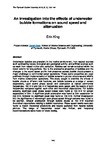An investigation into the effects of underwater bubble formations on sound speed and attenuation
| dc.contributor.author | King, E. | |
| dc.date.accessioned | 2019-05-20T09:26:07Z | |
| dc.date.available | 2019-05-20T09:26:07Z | |
| dc.date.issued | 2016 | |
| dc.identifier.citation |
King, E. (2016) 'An investigation into the effects of underwater bubble formations on sound speed and attenuation', The Plymouth Student Scientist, 9(1), p. 105-144. | en_US |
| dc.identifier.issn | 1754-2383 | |
| dc.identifier.uri | http://hdl.handle.net/10026.1/14118 | |
| dc.description.abstract |
Underwater bubbles are prevalent in the marine environment, from natural sources such as breaking waves, biological and geological activity, and artificial sources such as wash from vessel motion and cavitation. Bubbles can remain entrained within the water column for long periods. Due to the attenuative properties of bubbles and the changes to the sound speed profile their presence causes, bubble clouds present a major challenge to commercial sonar operations. These same properties are used positively through implementation of bubble screens to protect structures and wildlife from marine construction operations. This study sought to examine the effects of bubble clouds at different void fractions, and bubble screens at a range of screen separations, upon sound phase speed and attenuation at typical commercial frequencies. 195 kHz and 500 kHz frequencies were tested, and the results of both frequencies compared against each other and theoretical expectations. For bubble screens, significant peak phase speed losses were found at 195 kHz for screen separations of 3cm. A significant peak attenuation was found at 3cm separation for 500 kHz, however no significant peak was found at 195 kHz. Further investigation into the significance of wavelength upon phase speed through screens was found to be justified. Greater attenuation through bubble clouds at 195 kHz matched theoretical expectations relating to bubble resonance. Phase speed results were also found to match theoretical predictions and results gathered from natural bubble plumes. The range of frequencies tested was limited, and frequency recommendations were made for future testing. | en_US |
| dc.language.iso | en | en_US |
| dc.publisher | University of Plymouth | |
| dc.rights | Attribution 3.0 United States | * |
| dc.rights.uri | http://creativecommons.org/licenses/by/3.0/us/ | * |
| dc.subject | Underwater bubbles | en_US |
| dc.subject | water | en_US |
| dc.subject | bubble formation | en_US |
| dc.subject | sound | en_US |
| dc.subject | attenuation | en_US |
| dc.subject | vessel motion and cavitation | en_US |
| dc.subject | frequencies | en_US |
| dc.subject | natural bubble plumes | en_US |
| dc.subject | marine environment | en_US |
| dc.title | An investigation into the effects of underwater bubble formations on sound speed and attenuation | en_US |
| dc.type | Article | |
| plymouth.issue | 1 | |
| plymouth.volume | 9 | |
| plymouth.journal | The Plymouth Student Scientist |



